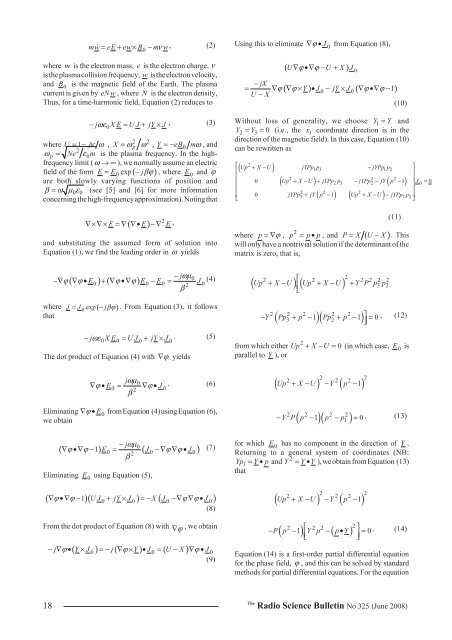Radio Science Bulletin 325 - June 2008 - URSI
Radio Science Bulletin 325 - June 2008 - URSI
Radio Science Bulletin 325 - June 2008 - URSI
- No tags were found...
You also want an ePaper? Increase the reach of your titles
YUMPU automatically turns print PDFs into web optimized ePapers that Google loves.
mwÆ = eE + ew× B −mνw , (2)where m is the electron mass, e is the electron charge, νis the plasma collision frequency, w is the electron velocity,and B 0 is the magnetic field of the Earth. The plasmacurrent is given by eN w , where N is the electron density,Thus, for a time-harmonic field, Equation (2) reduces to00− jωεXE = UJ + jY× J , (3)2 2where U = 1− jν ω , X = ωpω , Y =− eB0mω , and2ωp = Ne ε0mis the plasma frequency. In the highfrequencylimit (ω →∞), we normally assume an electricfield of the form E = E 0 exp ( − jβϕ ) , where E 0 and ϕare both slowly varying functions of position andβ = ω µ 0ε0(see [5] and [6] for more informationconcerning the high-frequency approximation). Noting that( )2∇×∇× E =∇ ∇• E −∇ E ,and substituting the assumed form of solution intoEquation (1), we find the leading order in ω yields− jωµ0−∇ϕ( ∇ ϕ• E0) + ( ∇ ϕ• ∇ϕ) E0 − E0 = J (4)2 0βwhere J = J 0 exp ( − jβϕ ). From Equation (3), it followsthat− jωεXE = UJ + jY× J . (5)0 0 0 0The dot product of Equation (4) with∇ ϕ yieldsjωµ0∇ ϕ• E0 = ∇ ϕ• J . (6)2 0βEliminating ∇ ϕ • E0from Equation (4) using Equation (6),we obtain− jωµ∇ •∇ − 0 =2 0 −∇ ∇ • (7)0β0( ϕ ϕ 1) E ( J ϕ ϕ J )Eliminating E 0 using Equation (5),( ∇ ϕ•∇ϕ − 1)( UJ + jY× J ) = −X( J −∇ϕ∇ ϕ•J )0 0 0 0From the dot product of Equation (8) with ∇ ϕ , we obtain( ) ( ) ( )(8)−j∇ ϕ• Y× J0 = −j ∇ ϕ× Y • J0 = U − X ∇ ϕ•J0(9)Using this to eliminate ∇ ϕ • J0from Equation (8),( U∇ ϕ•∇ϕ− U + X) J 0− jX= ∇ ( Y) J0 jY J0( 1)U X ϕ ∇ ϕ × • − × ∇ ϕ •∇ ϕ −−(10)Without loss of generality, we choose Y1= Y andY2 = Y3 = 0 (i.e., the x 1 coordinate direction is in thedirection of the magnetic field). In this case, Equation (10)can be rewritten as2( )⎡ Up + X −U jYPp1p 3 −jYPp1p⎤2⎢⎥⎢2 2 2 ⎥⎢ 0 ( Up + X − U ) + jYPp2p3 −jYPp2 − jY ( p − 1)⎥J0 = 0⎢⎥2 2 2⎢ 0 jYPp3 + jY ( p − 1) ( Up + X −U ) − jYPp3p2⎥⎣⎦2(11)where p =∇ ϕ , p p p P = X U − X . Thiswill only have a nontrivial solution if the determinant of thematrix is zero, that is,= • , and ( )⎡( ) ( ) 2⎢2 + − 2 + − +2 2 3 2 22Up X U Up X U Y P p p⎣( 3 )( 2 )− + − 1 + − 1 = 0 , (12)⎥⎦2 2 2 2 2Y Pp p Pp p ⎤2from which either Up + X − U = 0 (in which case, E 0 isparallel to Y ), or2 2 2( Up + X −U ) −Y ( p −1)2 2( )( )2 2 2 21−Y P p −1 p − p = 0 , (13)for which E 0 has no component in the direction of Y .Returning to a general system of coordinates (NB:2Yp1= Y• p and Y = Y • Y ), we obtain from Equation (13)that2 2 2( Up + X −U ) −Y ( p −1)2 22 ⎡ 2 2( ) ( ) 2−P p −1 Y p p Y⎤⎢− •⎥= 0 . (14)⎣⎦Equation (14) is a first-order partial differential equationfor the phase field, ϕ , and this can be solved by standardmethods for partial differential equations. For the equation18The<strong>Radio</strong> <strong>Science</strong> <strong>Bulletin</strong> No <strong>325</strong> (<strong>June</strong> <strong>2008</strong>)
















